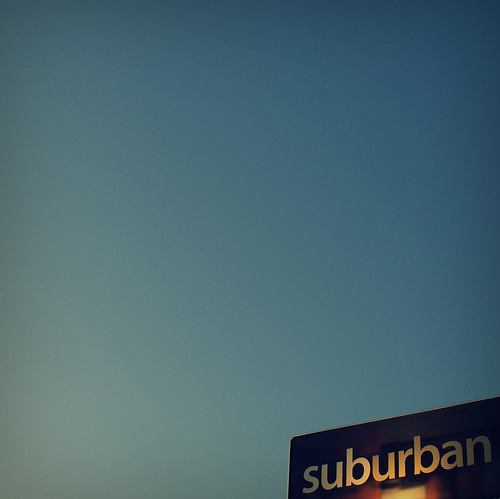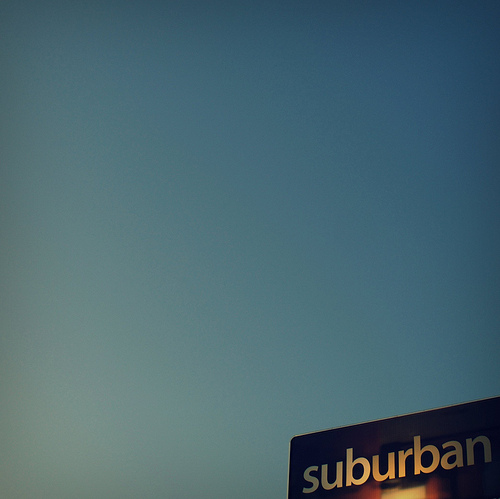 What’s in a name?Photo: Ryan BowmanWhat is the difference between a city and a suburb, anyway?
What’s in a name?Photo: Ryan BowmanWhat is the difference between a city and a suburb, anyway?
It’s an important question because so many times, the debate about the allocation of resources in our country is framed this way, as if there were some kind of obvious dichotomy between suburbs and cities, some bright line that separates them.
Not only that, the cities/suburbs polarization often takes on the nasty flavor of a culture war.
Here’s the thing, though: There is no bright line.
That’s the point Christopher Leinberger makes as he tries to reposition the question, with a post at The New Republic called “Cities Versus Suburbs Is the Wrong Debate.”
In it, he takes on the gleeful apologists for sprawl (Joel Kotkin, Wendell Cox, et al.) who have been rubbing their hands over lackluster population growth figures in the nation’s core cities, as revealed in the 2010 census. Leinberger compares demographers to a drunk looking for his lost keys under a lamppost because “This is where the light is.” Here’s what he says about that questionable illumination:
Unfortunately, the census shines the light on the terms “city” and “suburb” — neither of which are the keys to understanding today’s built environment ….
The issue is where are walkable urban places being built, and they are being built in both central cities and the suburbs surrounding them. My 2007 survey of the walkable urban places in the top 30 metros showed 50 percent of them were in central cities and 50 percent were in the suburbs. In the metro area with the most walkable urban places, the Washington region, 70 percent of the walkable urban places were in the suburbs. These included Bethesda and Silver Spring in suburban Montgomery County, nine places in suburban Arlington County (like Ballston and Crystal City), and the newly built Washington Harbor in suburban Prince George’s County.
Until we focus on the form of the built environment, walkable urban versus drivable suburban, we will be that drunk under the street light trying to find our lost keys.
Additionally, the major evidence of the demand for walkable urban places, both center city and in the suburbs, is that the market demands a premium for walkable urban houses, apartments, and office space. These high prices are perversely used by the skeptics to somehow prove this is a small niche market. To the contrary, high prices demonstrate the severe shortage of supply, leading to significant pent-up demand.
Here’s another reason the “suburbs vs. cities” trope is worn-out and useless: The trend of growing poverty in the places we know as “suburbs.”
Business Insider recently ran a slideshow about the increasing poverty in American suburbs. It has some facts and figures that emphasize the blurring of identity between what we think of as urban and suburban places:
Between 2000 and 2008, suburbs saw their poor populations grow by 25 percent — almost five times faster than urban poverty growth, according to Brookings.
Urban gentrification is one factor driving poor people out of cities. Other factors include immigration dynamics, the availability of affordable housing and the decentralization of jobs that pay lower wages.
In Houston, there has been a 7.3 percent shift of poverty to the suburbs. In Atlanta, it’s been 8.6 percent. In Cleveland, 9.3 percent.
And suburbs are by no means immune to the traditional “urban” ill of decaying infrastructure. As Aaron Renn at The Urbanophile points out, sprawl is expensive to maintain, and we don’t have any real strategy to deal with it as it ages (kind of the way we don’t have a strategy to deal with the aging Boomers that started building this infrastructure, come to think of it):
I do think we should invest in cities and can build urban environments that attract a lot more people. But equally if not more important is to build better suburbs. What we see in America today is a suburban form that is unsustainable. I don’t mean that in the traditional sense of the word when it comes to the environment. I mean that it is simply financially unsustainable. Unlike urban environments, all too many suburbs have proven tragically unable to reinvent themselves. Thus as soon as they get old and lose the advantages of greenfield economics, they are abandoned in favor of new edge development. Plenty of these places are going to be in big trouble when their aging-in-place residents pass on with no next generation in the wings. The vast tracts of decaying inner ring suburbs across America may prove to be our most vexing “urban” problem of the next few decades.
Let’s not look at economics to the exclusion of more intangible but no less important concerns. What about the type of lives that people are living? The other day, I came upon a post by planner Dom Nozzi:
The most profound influence on community quality of life is directly related to how much effort the community puts into catering to cars. And the astonishing fact is this: Most all of us either don’t realize, or are too timid to point out, that there is an inverse relationship between happy cars and happy people. That is, the happier we try to make cars by building wide, multi-lane, high-speed roads, creating enormous (and unpriced) parking lots, and setting buildings an enormous distance away from these now hostile roads, the worse conditions become for people — at least for those people seeking a more walkable, sociable lifestyle, and to some extent, for those who seek a more drivable lifestyle.
Higher gas prices, shrinking state and municipal budgets, environmental degradation, diminishing resources, overstressed humans stuck in endless commutes: All factors are pointing the way toward the need for places for people to live and work that are more compact, more walkable, richer in transit, more sustainable both environmentally and fiscally.
Call them what you will.



